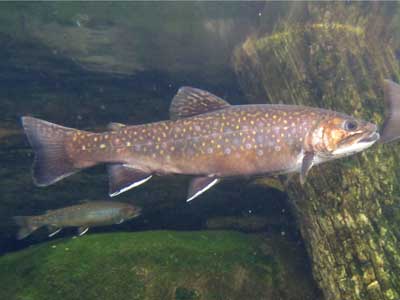
The brook trout is found in cool, clear streams of the Mid Atlantic. One of North America’s most beautiful fish, the brook trout is distinguished from rainbow trout and brown trout by its pattern of tan and pinkish spots, and squared tail. Its orange pectoral and anal fins are bordered with white and black.
Brook trout are present in several Mid Atlantic rivers, including upper reaches of the Delaware, Susquehanna, Savage, Patapsco, Patuxent, and Potomac. They are also present in unpolluted streams of the Applachian region.
Mid Atlantic brook trout populations have declined considerably in the last few decades. A variety of factors have been linked to the decline of brook trout, including habitat loss, pollution, and rising water temperatures. According to biologists, brook trout cannot tolerate water temperatures which exceed 70 degrees for long periods of time.
A study by Maryland’s Department of Natural Resources found that brook trout populations fell considerably in areas where deforestation and development occurred. In several Maryland streams, brook trout disappeared entirely when their habitat changed.
In 2007, Maryland adopted new regulations that eliminated the harvesting of brook trout. The use of bait was also restricted in some areas due to brook trout mortality issues.
The brook trout is the only member of the trout family native to the Eastern Seaboard. It is the state fish of several Mid Atlantic states including Pennsylvania, New Jersey, and Virginia (freshwater).